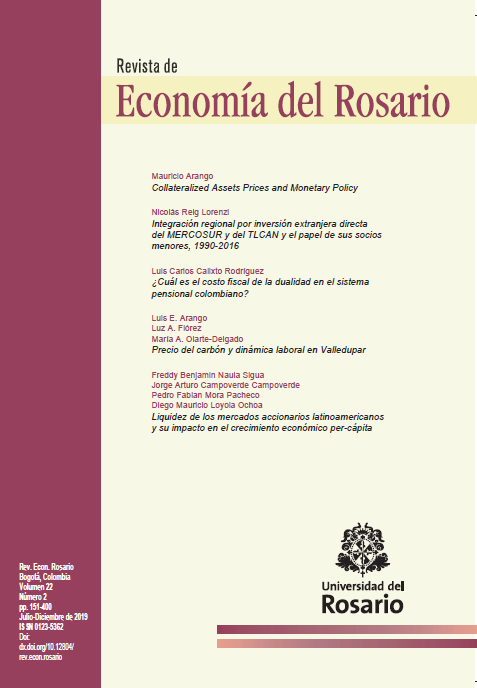Activos Hipotecables y Política Monetaria
Barra lateral del artículo
Contenido principal del artículo
Un sistema financiero bien informado y cauteloso puede mejorar el bienestar de una economía al canalizar los excedentes de los ahorradores a los prestatarios. Sin embargo, en una situación de crisis, el menor precio de bienes hipotecables limita la capacidad de crédito de la economía, generando la posibilidad de una reducción en el crédito inclusive en un escenario de bajas tasas de interés. Este documento ilustra el punto anteriormente mencionado através de un modelo de equilibrio general en el que el uso de activos como colateral determina que tan riesgoso es el comportamiento del sistema financiero. Esta y varias otras condiciones amplifican la magnitud de un choque de productividad negativo
Descargas
Aghion, P., & Bolton, P. (1997). A theory of trickle-down growth and development. Review of Economic Studies,64(2), 151-72.
Aliaga-Díaz, R., & Olivero, M. P. (2010). Is there a financial accelerator in us banking?: Evidence from the cyclicality of banks’ price-cost margins. Economics Letters, 108(2), 167-171.
Aoki, K., Proudman, J., & Vlieghe, G. (2004). House prices, consumption, and monetary policy: a financial accelerator approach. Journal of Financial Intermediation, 13(4), 414-435.
Arango, M., Posada, C. E., & Tamayo, J. A. (2011). El sistema crediticio, la po- lítica monetaria y un posible origen deciclos y crisis financieras. Ensayos Sobre Política Económica, 29(64), 32-61.
Associated Press (March 13, 2007). Will subprime mess ripple through eco- nomy? Q&A: Looking at the impact of the mortgage meltdown at NBC News. Retrieved from http://www.nbcnews.com/id/17584725/ns/business-re- al_estate/t/will-subprime-mess-ripple-through-economy/#.XPrahi1Dl0c
Bernanke, B., & Lown, C. (1991).The credit crunch. Brookings Papers on Economic Activity, 22(2), 205-248.
Bernanke, B., & Gertler, M. (1989). Agency costs, net worth, and business fluctuations. American Economic Review, 79(1), 14-31.
Bernanke, B., Gertler, M., & Gilchrist, S. (1998). The financial accelerator in a quantitative business cycle framework. Working Papers 98-03. New York University.
Bernanke, B., Gertler, M., & Gilchrist, S. (1996). The financial accelerator and the flight to quality. The Review of Economics and Statistics, 78(1), 1-15.
Bordo, M. D. (2008). An historical perspective on the crisis of 2007-2008. NBER Working Papers 14569. Retrived from ttps://www.nber.org/ papers/w14569.pdf
Brunnermeier, M. K. (2008). Deciphering the liquidity and credit crunch 2007-08. NBER Working Papers 14612. Retrieved from https://www.nber.org/ papers/w14612.pdf
Brzoza-Brzezina, M., & Makarski, K. (2011). Credit crunch in a small open economy. Journal ofInternational Money and Finance, 30(7), 1406-1428.
Calvo, G. A. (1983). Staggered prices in a utilitymaximizing framework. Journal of Monetary Economics, 12(3), 383-398.
Calza, A., Monacelli, T., & Stracca, L. (2009). Housing finance and monetary policy. Working Paper Series 1069, European Central Bank. Retrieved from http://citeseerx.ist.psu.edu/viewdoc/download?doi=10.1.1.165.4037&rep=rep1&type=pdf
Campbell, J. R., & Hercowitz Zvi. (2005). The role of collateralized household debt in macroeconomic stabilization. NBER Working Papers 11330. Re- trieved from https://www.nber.org/papers/w11330.pdf
Carlstrom, C. T., & Fuerst, T. S. (2006). Co-movement in sticky price models with durable goods. Working Paper 0614, Federal Reserve Bank of Cleveland. Re- trieved from https://www.clevelandfed.org/en/newsroom-and-events/ publications/working-papers/working-papers-archives/2006-working- papers/wp-0614-co-movement-in-sticky-price-models-with-durable- goods.aspx
DiMartino, D., & Duca, J. V. (2007). The rise and fall of subprime mortgages. Economic Letter, 2(11).
Diamond, D. W., & Rajan, R. G. (2009). The credit crisis: Conjectures about causes and remedies. American Economic Review, 99(2), 606-610.
Faia, E., & Monacelli, T. (2007). Optimal interest rate rules, asset prices, and credit frictions. Journal of Economic Dynamics and Control, 31(10), 3228-3254.
Galí, J. (2008). Monetary policy, inflation, and the business cycle: An introduction to the new Keynesian framework. Princeton: Princeton University Press.
Gertler, M. (1992). Financial capacity and output fluctuations in an economy with multi-period financial relationships. Review of Economic Studies, 59(3), 455-72.
Gjerstad, S., & Smith, V. L. (April 6, 2009). From bubble to depression? The Wall Street Journal. Retrieved from https://www.wsj.com/articles/ SB123897612802791281
Greenspan, A. (2007). The age of turbulence: Adventures in a new world. Penguin Press Publication. New York.
Greenwald, B. C., & Stiglitz, J. E. (1993). Financial market imperfections and business cycles. NBER Working Papers 2494. Retrieved from https:// www.nber.org/papers/w2494.pdf
Iacoviello, M. (2005). House prices, borrowing constraints, and monetary policy in the business cycle. American Economic Review, 95(3), 739-764.
Kiyotaki, N., & Moore, J. (1997). Credit Cycles. Journal of Political Economy, 105(2), 211-48.
Kocherlakota, N. R. (2000). Creating business cycles through credit constra- ints. Quarterly Review, Federal Reserve Bank of Minneapolis, 2-10.
Krugman, P. (August 29, 2005). Greenspan and the bubble. The New York Times. Retrieved from https://www.nytimes.com/2005/08/29/opinion/ greenspan-and-the-bubble.html
Krusell, P., & Smith Jr., A.-A. (1998). Income and wealth heterogeneity in the macroeconomic. Journal of Political Economy, 106, 867-896.
Lahart, J. (May 16, 2008). Bernanke’s bubble laboratory Princeton protégés of fed chief study the economics of manias. The Wall Street Journal. Retrieved from https://www.wsj.com/articles/SB121089412378097011
Mendoza, E. G., & Terrones, M. E. (2008). An anatomy of credit booms: Evidence from macro aggregates and micro data. NBER Working Papers 14049. Retrieved from https://www.nber.org/papers/w14049.pdf
Miller, M., & Stiglitz, J. E. (2010). Leverage and asset bubbles: Averting armageddon with chapter 11? NBER Working Papers 16817. Retrieved from https://www.nber.org/papers/w15817.pdf
Mishkin, F. S. (2009). Is monetary policy effective during financial crises? NBER Working Papers 14678. Retrieved from https://www.nber.org/ papers/w14678.pdf
Monacelli, T. (2009). New Keynesian models, durable goods, and collateral constraints. Journal of Monetary Economics, 56(2), 242-254.
Nerlove, M., & Bessler, D. A. (2001). Expectations, information and dynamics. In B. L. Gardner & G. C. Rausser (Eds.), Handbook of Agricultural Economics, volume 1 (pp. 155-206). Elsevier.
Reinhart, C. M., & Rogoff, K. S. (2009). The aftermath of financial crises. NBER Working Papers 14656. Retrieved from https://www.nber.org/ papers/w14656.pdf
Smets, F., & Wouters, R. (2003). An estimated dynamic stochastic general equilibrium model of the Euro area. Journal of the European Economic Association, 1(5), 1123-1175.
Taylor, J. B. (December 1993). Discretion versus policy rules in practice. Carnegie-Rochester Conference Series on Public Policy, 39(1), 195-214.
Taylor, J. B., & Williams, J. C. (2010). Simple and robust rules for monetary policy. NBER Working Papers 15908. Retrieved from https://www.nber. org/papers/w15908.pdf
Walsh, C. (2010). Monetary theory and policy. Cambridge: The MIT Press.



